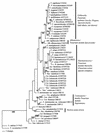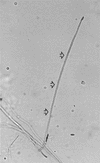Analysis of phylogenetic relationship of Cylindrocarpon lichenicola and Acremonium falciforme to the Fusarium solani species complex and a review of similarities in the spectrum of opportunistic infections caused by these fungi
- PMID: 12149344
- PMCID: PMC120680
- DOI: 10.1128/JCM.40.8.2866-2875.2002
Analysis of phylogenetic relationship of Cylindrocarpon lichenicola and Acremonium falciforme to the Fusarium solani species complex and a review of similarities in the spectrum of opportunistic infections caused by these fungi
Abstract
An emerging pattern of similarity in medical case reports led to a project to compare the phylogenetic affinities of two well-known tropical fungal opportunistic pathogens, Cylindrocarpon lichenicola and Acremonium falciforme, to members of the Fusarium solani species complex. C. lichenicola and A. falciforme, despite their deviating conidial morphologies, were shown via sequencing of the ribosomal large subunit to be well instituted within a clade mainly consisting of typical F. solani strains and other species until recently considered variants of F. solani. The original name Fusarium lichenicola C. B. Massalongo is reestablished, and the new combination F. falciforme is made. Recognition of these species as fusaria is necessary for correct interpretation of current and future molecular diagnostic tests. Reevaluation of species morphology in light of the molecular findings showed that certain features, especially elongate filiform conidiophores with integrated terminal phialides, facilitate correct microscopic classification of these atypical Fusarium species. There is a strong and underrecognized overlap in the spectra of cases caused by members of the F. solani clade, particularly ocular infections, mycetomas, and, in the neutropenic host, disseminated and other serious systemic infections. A novel synthesis of case reports shows that patients from areas with warm climates may develop a distinctive fusarial intertrigo caused by F. solani, Fusarium lichenicola, or Fusarium oxysporum.
Figures




References
-
- Affeldt, J. C., H. W. Flynn, R. K. Forster, S. Mandelbaum, J. G. Clarkson, and G. D. Jarus. 1987. Microbial endophthalmitis resulting from ocular trauma. Ophthalmology 94:407-413. - PubMed
-
- Booth, C. 1966. The genus Cylindrocarpon. Mycol. Papers 104:1-58.
-
- Bugnicourt, F. 1939. Les Fusarium et Cylindrocarpon de l'Indochine, p. 1-206. In P. Lechevalier (ed.), Encyclopédie mycologique. P. Lechevalier, Paris, France.
-
- Cameron, J. A., E. M. Badawi, P. A. Hoffman, and K. F. Tabbara. 1996. Chronic endophthalmitis caused by Acremonium falciforme. Can. J. Ophthalmol. 31:367-368. - PubMed
-
- Chandenier, J., M. P. Hayette, C. de Bièvre, P. F. Westeal, J. Petit, J. M. Achard, N. Bove, and B. Carme. 1993. Tuméfaction de la jambe à Neocosmospora vasinfecta chez un transplanté rénal. J. Mycol. Med. 3:165-168.
MeSH terms
Substances
LinkOut - more resources
Full Text Sources
Other Literature Sources
Molecular Biology Databases

